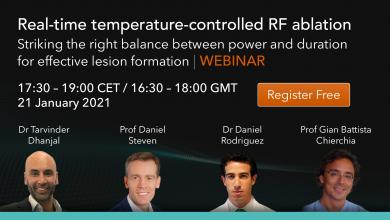Search results
Author(s):
Tarv Dhanjal
,
Daniel Steven
,
Daniel Rodriguez
,
et al
Start date:
Jan 21, 2021
View more
Author(s):
Francisco G Cosio
Added:
3 years ago
The term ‘flutter’ was coined to designate the visual and tactile rapid, regular atrial contraction induced by faradic stimulation in animal hearts, in contrast with irregular, vermiform contraction in atrial fibrillation (AF).1,2 On the ECG, flutter was a regular continuous undulation between QRS complexes at a cycle length (CL) of ≤250 ms (≥240 bpm). Slower tachycardias displaying discrete P…
View more
Author(s):
Steven M Markowitz
,
George Thomas
,
Christopher F Liu
,
et al
Added:
3 years ago
Pioneering electrophysiology studies in the 1990s defined the anatomical boundaries of typical atrial flutter, identified regions for effective catheter ablation of this arrhythmia and described procedural endpoints to minimise recurrences after ablation. Activation and entrainment mapping demonstrated that typical flutter arises from reentry around the tricuspid annulus.1 Criteria to confirm…
View more
Author(s):
Demosthenes G Katritsis
,
Giuseppe Boriani
,
Francisco G Cosio
,
et al
Added:
3 years ago
Endorsed by Heart Rhythm Society (HRS), Asia-Pacific Heart Rhythm Society (APHRS), and Sociedad Latinoamericana de Estimulación Cardiaca y Electrofisiologia (SOLAECE)
This is an executive summary of the full consensus document on the management of supraventricular tachycardia (SVT) patients published in Europace. The consensus document was prepared by a Task Force from the European Heart Rhythm…
View more
Author(s):
Carina Blomström-Lundqvist
,
Tatjana S Potpara
,
Helena Malmborg
Added:
3 years ago
With the advent of successful surgical repairs and modern diagnostic techniques, an increasing number of patients with congenital heart disease survive to adulthood. Despite these improvements, the surgical corrective atrial incisions performed during childhood lead to subsequent myocardial scarring that have the inherent risk of harbouring substrates for macro-reentrant atrial tachycardias …
View more
Author(s):
Rajdip Dulai
,
Fatima Bangash
,
Ajay Sharma
,
et al
Added:
4 months ago
ATs After AF Ablation
Author(s):
Yuan Hung
,
Shih-Lin Chang
,
Wei-Shiang Lin
,
et al
Added:
3 years ago
Article
Author(s):
Yoga Waranugraha
,
Ardian Rizal
,
Mohammad Saifur Rohman
,
et al
Added:
1 year ago
Body Surface Electrocardiographic Mapping for Non-invasive Identification of Arrhythmic Sources
Author(s):
Ashok J Shah
,
Meleze Hocini
,
Patrizio Pascale
,
et al
Added:
3 years ago
Article
Author(s):
Charles M Pearman
,
Shi S Poon
,
Laura J Bonnett
,
et al
Added:
3 years ago
The goal of arrhythmia eradication in AF continues to be elusive for cardiac electrophysiologists. Although endocardial radiofrequency (RF) catheter ablation is more effective than pharmacological management at maintaining sinus rhythm,1 it is far from perfect, especially in patients with non-paroxysmal AF.2 In an attempt to address this, attention has turned back to the surgical ablation that…
View more















